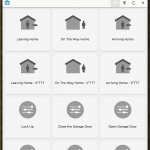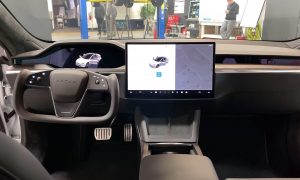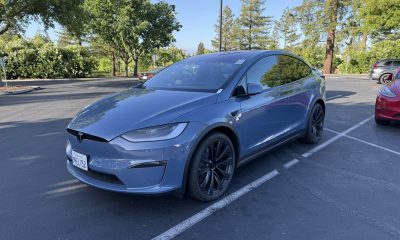Apps
Linking your Tesla to a connected home and beyond

Get home from work, unlock the door, turn off the alarm system, turn on the heat, pre-heat the oven… all just a part of the daily grind. What if rather than doing all of that when you walk in the door, you could do it on your commute – or better yet, not at all? As our ability to connect devices and allow them to interact increases, so does the flexibility and efficiency of our lifestyle. And all of these interactions – and the potential for so much more – are made possible through the Internet of Things (IoT).
The connected car can now count itself as one of the key players in this new connected world. Tesla continues to be driving vehicle interconnectivity, bringing down the physical and communication barriers that once separated driver, home, car and office. Now, through the power of the “Internet of Things,” your Tesla can act as a digital trigger: starting actions and alerting you to going-ons in all aspects of your life – with and without any input from you.
How is the connected car linked to the connected home?
Essentially, your Tesla can be connected to your home in two ways.
First, as a “trigger” to initiate an action. For example, your car can interact with your house to trigger automatic responses based on its proximity. Let’s say you arrive home from work. Your Tesla can tell your smart home you’ve just arrived, and your home can jump into action by opening the garage, adjusting the thermostat, turning on the porch light and maybe starting up your favourite tunes on your stereo (unfortunately it can’t pour you a drink – yet.)
Second, your Tesla can receive messages or “options” as they’re known. What would happen if the smoke detector went off and no one was home? By the time you found out, it might be too late to act. But with the option to receive alerts from connected home alarms, your Tesla can inform you and ensure fast response in the event of an emergency.
Notifications can go beyond just emergencies, of course. Currently you can be informed when your favorite sports team wins a game, or when your teenager arrives home (assuming they enter the house through a connected door or window!) As new notifications are developed, they’ll very likely become available to exchange between your Tesla and your home.
What could a person with a connected home/car combination do when they arrive home?
The connection of your car and home has interesting implications for streamlining and simplifying your life. As soon as you arrive home, your Tesla can spur technology into action. Everything from adjusting the temperature of your home to unlocking the door — minor tasks we take for granted could all become much easier and fully automatic. Not to mention the fact that these automated actions can help save energy, and reduce your carbon footprint.

Geo-based triggering of routines directly from the Model S and Model X web browser handled through EVE for Tesla
And what’s possible for you will only continue to grow. As the technology and connectivity of the Internet of Things expands, so will the convenience it affords. From preheating the oven for dinner when you’re 15 minutes away to triggering the kettle to boil you a cup of tea, your connected Tesla has the potential to make your life easier and more efficient.
How can the connected car/home help with family?
One thing many Tesla owners will find value in is how their car can augment interactions with their families.
First and foremost is peace of mind. If your school-aged child is at home, the last thing you want to be worried about is whether or not you locked the door when you left. Your connected Tesla can make sure this is automatic — and not something forgettable.
There’s also an application for seniors who may be vulnerable to falls. Your connected car can sync with fall-alert devices so you can keep a close eye on your parents and take quick action in the event of an accident.
Beyond these security measures, a connected car can make your family life easier. Just think — you’re juggling groceries, your kids and your work bag in the pouring rain. The last thing you want is to fumble with your keys at the door for any length of time. Of course, when it unlocks automatically as you pull in the drive, this ceases to be an issue.
And what about those reminders from your spouse? No longer do they manifest as an easily-misplaced piece of crumpled paper. Now you can get notifications to pick up milk on your way home, so you don’t have to say “sorry” for forgetting. You can even have your Tesla let your family know you’re on the way home using SMS or email, so they’re not worried when you’re late.
What does the future hold for connected cars and homes?
Even twenty years ago, no one could predict the connectivity we would be able to achieve in our lives now. As technology progresses, we can only guess at its future applications.
Currently, connected home devices run the gamut of the usual suspects (lights, doors, windows, alarms, heating/cooling systems). Entertainment systems (TV, stereo) are also well represented in this class. Connected switches and outlets offer the possibility of connecting even unconnected devices (currently my Christmas tree lights are connected through such an outlet – and my four-year old can ask Alexa, Amazon’s connected home assistant, to turn them off and on.) Even major appliances have gotten into the mix with connected refrigerators. Although they can’t yet inventory your existing groceries, you can use them to start a shopping list, or order more ice cream.
That said, we’re already identifying gaps in convenience and efficiency. As video technology improves, its being applied to mundane tools like the doorbell. You can now video chat with the person on the other side from anywhere in the world, and this potential could extend to your car too.
More video applications are on the horizon as well. Monitoring pets and young children is increasingly becoming a priority for homeowners. Soon, this will be possible from the convenience of anywhere, and anytime.
Services like IFTTT exponentially increase the potential for interactions between connected devices and services, through the simple use of the formula “if this then that”. IFTTT enables hundreds of products and services to interact with each other through this simple formula. With your connected Tesla, you can use this to do things like get notifications of important emails, automatically keep and vehicle use log, even have your Tesla send emails and text messages for you.
All in all, the future looks bright for Tesla owners seeking a connected, convenient, and efficient life!
EVE for Tesla
Although Tesla Motors’ vehicles can manipulate garage doors and even park themselves, Tesla owners looking to connect their smart home, or enable connected abilities such as those mentioned (above along with many others) will want to check out Evolved Vehicle Environments EVE for Tesla.
EVE for Tesla currently connects to about 30 different devices with support for over 500 devices and multiple smart home platforms coming very soon. It also integrates with IFTTT allowing you to connect your Tesla in thousands of different ways to hundreds of products and services.
You can check out Teslarati’s review of EVE for Tesla here.
What about your connected car and the rest of the world?
By now I’m sure you’ve all heard about the potential for connected city infrastructure. We’ve had lights that change based on traffic for a while, and transit signal priority lights – but neither of these needed the Internet of Things to work. But a connected city can do more than just change lights – with a system of connected infrastructure you can see how it would be possible to reroute traffic in the event of an emergency, or redistribute traffic to ease congestion. And it could do it all automatically – by communicating with the cars that are traveling within it.
Connected cars communicating directly with each other also have significant implications for traffic and safety. Similar systems used on trains allow those trains to travel more closely together, increasing the number of trains capable of being run on a track over a specified period of time. Hypothetically the same should be possible for connected cars. Enter emergency vehicles into the equation and it may be possible to speed up emergency response time, and potentially save lives.
In our next post we will continue to explore connected cars and the Internet of Things, and how autonomous vehicles may change the way we live.
-Jason Taylor
Apps
Tesla plans to put Insurance, FSD subscription directly into smartphone app

Tesla is planning to put its Insurance program and upcoming Full Self-Driving subscription directly into its Smartphone app, according to a software engineer who recently reverse-engineered parts of the automaker’s application.
Reddit u/Callump01 dug into the Tesla Smartphone App that owners use to do anything from control the vehicle’s climate to performing Smart Summon.
After reverse-engineering the app, Callump01 found several new things, including Tesla Insurance’s planned integration, a Safety Ratings feature, and a Simulator that will allow owners to see how driving changes will affect their rates.
Tesla Insurance Integration: Safety Ratings and Simulator
Tesla will have its Insurance program directly integrated into the application, according to Callump01. It will be located in its own defined section, and will be more readily available to owners, and could save time by helping avoid time-consuming phone calls. Many insurance companies, like GEICO, have apps where everything from filing a claim to getting insurance for a new car can be done from the touch of your fingertips.
There will also be a new “Safety Ratings” section. This will track your vehicle and is directly linked to your insurance if you use Tesla’s in-house program.
u/Callump01 said (via r/TeslaMotors):
“It will show the number of hours you’ve driven, how often you use AutoPilot, ABS events, forward collision warnings, autosteer strikeouts, accelerator variance, and many other metrics on both a per-trip and monthly basis, which you’ll be able to see in a neat graphical interface. You are given a ‘pass’ or ‘fail’ rating (though it is unclear whether that rating will be visible to the end user) and, from what I can tell, appears to be exclusive to HW2 and above and software version 2021.4.12 is required.”
Additionally, a “Simulator” section will allow owners to adjust factors related to categories that will affect rates. These include, but are not limited to ABS Activation, Hours Driven, Forced Autopilot Disengagements, Forward Collision Warnings, Unsafe Following Time, and Intensity of Acceleration and Braking.
u/Callump01 adds:
“Performance indicators are based on an average for that factor. The more factors you get into the green the more you’ll save on your premium. Your actual premium will not change more than 50% in a month based on your driving behavior.”
This feature is similar to Allstate’s Drivewise device, a simple plug-in that tracks your safe-driving habits and adjusts your monthly rates based on several factors like speed, braking, time of day, and mileage.
Full Self-Driving Subscription
It appears that Tesla will also allow owners to control the upcoming release of the FSD Subscription program that the automaker has talked about for some time.
Elon Musk has said on several occasions that Tesla’s FSD subscription will be available in Q2 2021. However, with only a few weeks left in the quarter, it is unclear whether Tesla will achieve this timeframe.
However, it is definitely in the works based on what was found in the App related to the subscription feature.
Firstly, there will be an option to be refunded if the program isn’t right for you or if there was an accidental purchase. Tesla will request information from the purchaser on why they would like a refund.
There are also mentions of a “Weekend Mode” and “Travel Mode” for the subscription, but there are no more details on what these features will provide to owners. Billing periods appear to be monthly, according to what was seen.
Details are relatively sparse as of now, especially considering the Subscription hasn’t formally been released by Tesla yet. However, it is exciting to know that Tesla plans to make its app more robust for owners, allowing more ease of access to certain features.
What do you think? Let us know in the comments below, or be sure to email me at joey@teslarati.com or on Twitter @KlenderJoey.
Apps
Tesla video conference call service shows developers are ready for a Tesla App Store
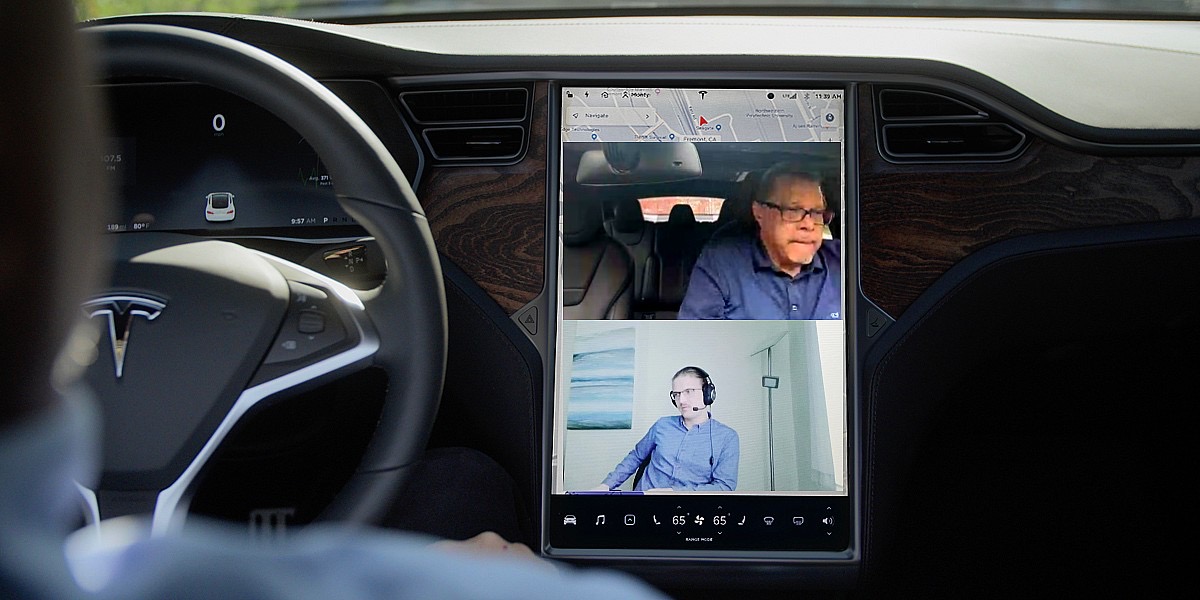
Over the years, vehicles have become another space for people to unwind and work. The pandemic has cemented the idea of in-car work spaces. Tesla’s cabins have become one of the most versatile spaces, partly thanks to its vehicles’ infotainment system.
Tesla Model S owner and CEO of Mass Luminosity Angel Munoz always believed his infotainment system could be put to better use.
For almost a year now, Munoz has been working on Beacon 4 Tesla, an in-car video conference service. Recently, Munoz invited Teslarati to join him and Beacon’s Senior VP of Technology Teodor Atroshenko for a video conference call inside his Tesla Model S.
“The process, the way it works is when you first set it up, you get into your Tesla, you launch the browser, you type in the BeaconX.com/Tesla. It shows you a QR code. You scan the QR code with your Beacon app and that logs you automatically into your car and then as soon as you join the call, the call basically appears on the screen there,” described Atroshenko.
How Beacon 4 Tesla Works
Munoz explained that Beacon 4 Tesla primarily worked through the driver’s phone at the moment.
“The phone does three functionalities. Number one, it streams the sound that [the Tesla passenger is hearing] through the speakers of the car. Two, you’re using the microphone [of the phone via bluetooth]. And three, it’s streaming the video that it’s receiving to your Tesla,” Munoz explained.
“So primarily, it’s the phone. Think about it that way, it’s primarily the phone right now since we don’t have access to the onboard computers and all that,” he said.

The final candidate for Beacon and Beacon 4 Tesla will be available in June. The services will officially launch on July 7, 2021. However, Beacon’s services are currently available for free for conference calls with up to six people.
Tesla owners interested in trying out Beacon 4 Tesla can use the service as well. Follow the instructions below:
1. Install the Beacon mobile app on your iOS (https://apple.co/2PVwMWG) and/or Android (https://bit.ly/3mk52XT) device.
2. Create a new Beacon account or login to an existing one.
3. Tap on the menu icon (vertical ellipsis) on the top-right corner and select “Synchronize Contacts.” This creates a quick list of people to call. Read Beacon’s Privacy Policy at https://beaconx.com/privacy
4. Now launch the Tesla’s web browser and navigate to https://beaconx.com/tesla. The screen will now display a unique QR code.
5. On your Beacon mobile app, tap on the menu icon (vertical ellipsis) and select “Scan Beacon Code.” Point your mobile phone’s camera to the QR code. You will be prompted to confirm logging in to your Beacon account.
6. You are all set! While your Tesla is parked tap on the webcam icon next to any contact name on your Beacon app to initiate a video conference call in your Tesla.
For more information on Beacon® visit https://BeaconX.com
Tesla App Store for developers
Munoz and Atroshenko believe that Beacon 4 Tesla could offer a much better experience if the in-car video conferencing service had access to the in-cabin cameras currently active in the Tesla Model 3 and Model Y. The Model S Plaid and Model X Plaid will have cameras facing the cabin and a more powerful infotainment system. The Plaid Tesla vehicles also have surround sound speakers and noise cancellation features, technologies which can make in-car video conference calls very immersive.
“We would sign any kind of agreement with him [Elon Musk], if he just gives us access. And then it’d be a much better experience because it’s all tied in, there’d be an app on the Tesla instead of outside of the Tesla,” Munoz said.
Munoz and Atroshenko’s willingness to work with Tesla on Beacon’s in-car conferencing service hints that it may be time for the EV automaker to look into developing a dedicated Tesla App Store for third-party developers.
Munoz and Atroshenko did not set out to create Beacon 4 Tesla originally. They were simply enticed by the challenge of conducting video conference calls through Tesla’s infotainment system.
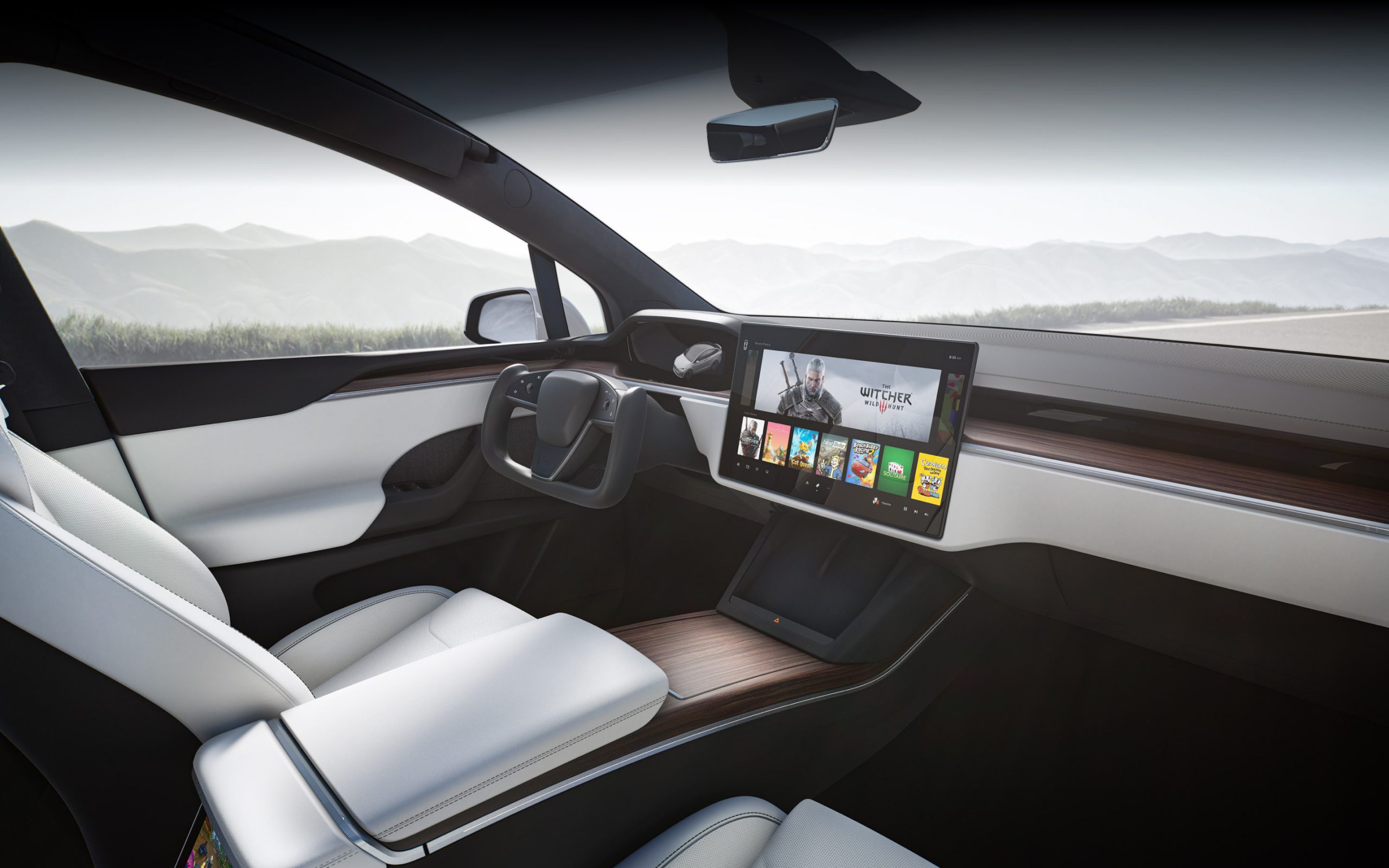
Atroshenko enumerated some of the challenges they faced while making Beacon 4 Tesla.
“We’re kind of making the best out of the situation—let’s put it that way. Because we can’t access the camera in Tesla. And the camera is not [an] HD camera. It has an overview of the interior, but basically it’s not up to par for video conferencing, at least not in this iteration. So hopefully the next cameras will be better, the ones facing the inside,” Atroshenko said.
After putting so much effort and work into the challenge, Munoz and Atroshenko want to share their work with all Tesla owners.
“Beacon 4 Tesla is free, so it comes with BeaconX. It’s our gift to Tesla and Elon Musk,” said Munoz. BeaconX is the conference call service the pair developed for laptops, phones and other devices.
Munoz and Atroshenko’s work hint that more app developers might be interested in building apps specifically for Tesla vehicles.
Tesla delivered almost 500,000 vehicles last year—despite the pandemic—and seems slated to deliver closer to 1 million cars in 2021. So far, Tesla has introduced a few in-car apps for drivers to use.
During the Q2 2020 earnings call, CEO Elon Musk and CFO Zachary Kirkhorn hinted that Tesla would launch a dedicated App Store once Full Self-Driving was ready and the company had a few million vehicles on the road. However, productive apps like Beacon 4 Tesla might be useful for Tesla passengers now.
Teslas used in ride-sharing fleets might benefit from an app store because apps could either entertain or make the ride more productive for passengers. Tesla apps might be useful for people who consider renting Tesla vehicles, too, especially for those on work trips or long family vacations traveling by car.
The Teslarati team would appreciate hearing from you. If you have any tips, email us at tips@teslarati.com or reach out to me at maria@teslarati.com.
Apps
Tesla’s new Powerwall update will coordinate vehicle charging during a power outage

Tesla has released a new software update for its Powerwall home battery system that will coordinate vehicle charging during a power outage.
The Tesla Powerwall will now take into account the energy needs of a home while charging the vehicle. If the home battery unit does not have enough energy to maintain the home’s essential needs and charge the vehicle, simultaneously, Powerwall will stop charging the Tesla vehicle.
In May 2019, Tesla CEO Elon Musk stated the feature would be “coming soon,” after Twitter follower and content creator DaErik asked if a better system could be enabled that would allow vehicles to not charge and use stored energy during outages. In February 2020, Tesla hinted at this update, citing Powerwalls ability to communicate more efficiently with charging vehicles. This would eliminate the possibility that vehicles would continue charging during an outage, thereby draining the Powerwall and leaving little energy left to power the home.
Tesla details the new Powerwall feature on its website:
“Powerwall now coordinates with Tesla vehicles during a power outage to charge your car without exceeding the energy and power capabilities of your Powerwall. The Powerwall reacts to the power needs of your home and will slow or stop your vehicle’s charging, keeping your home loads powered.
During a power outage, your Tesla vehicle will charge from the Powerwall whenever it is above the threshold set in the Tesla app. You can change this threshold to balance your home and transportation energy needs.
Keep your vehicle plugged in while the sun is shining, and surplus solar will charge your vehicle. Charging stops when Powerwall’s stored energy drops below your set threshold.”
Currently, the feature is available for the Model 3 and Model Y’s North American customers running software 2019.40.1 and newer. Owners must also have version 3.10.2 or later of the Tesla Mobile app, and software 1.46 or later on their Powerwall.
The behavior of the new system is outlined in a chart provided by Tesla as well, which shows Powerwall will make based on the state of its grid.

While the Powerwall is operating on a grid with any electric load, the vehicle will charge as usual. If there is a power outage in the area and Powerwall shows a surplus of energy that remains above the energy threshold, the system will then base the charging speed off of the home’s electric load if the load is low, the vehicle charges with surplus power and energy. If the load is high, the car will charge at a slower rate as the Powerwall will prioritize the needs of the home primarily.
Finally, if an outage is present and the Powerwall shows storage below the energy threshold, the car will automatically stop charging.
The advantages of this new system layout an easy system for owners who utilize both a Tesla vehicle and an energy storage system. Power outages are inconvenient for anyone, but luckily the new energy management system will allow owners not to charge their cars excessively while risking a possible disruption in power to their home.
-

 Elon Musk4 days ago
Elon Musk4 days agoTesla investors will be shocked by Jim Cramer’s latest assessment
-

 News1 week ago
News1 week agoTesla Robotaxi’s biggest challenge seems to be this one thing
-

 Elon Musk2 weeks ago
Elon Musk2 weeks agoFirst Look at Tesla’s Robotaxi App: features, design, and more
-

 News2 weeks ago
News2 weeks agoSpaceX and Elon Musk share insights on Starship Ship 36’s RUD
-

 News2 weeks ago
News2 weeks agoWatch Tesla’s first driverless public Robotaxi rides in Texas
-

 News1 week ago
News1 week agoWatch the first true Tesla Robotaxi intervention by safety monitor
-

 News2 weeks ago
News2 weeks agoTesla has started rolling out initial round of Robotaxi invites
-

 Elon Musk2 weeks ago
Elon Musk2 weeks agoTesla to launch in India in July with vehicles already arriving: report


